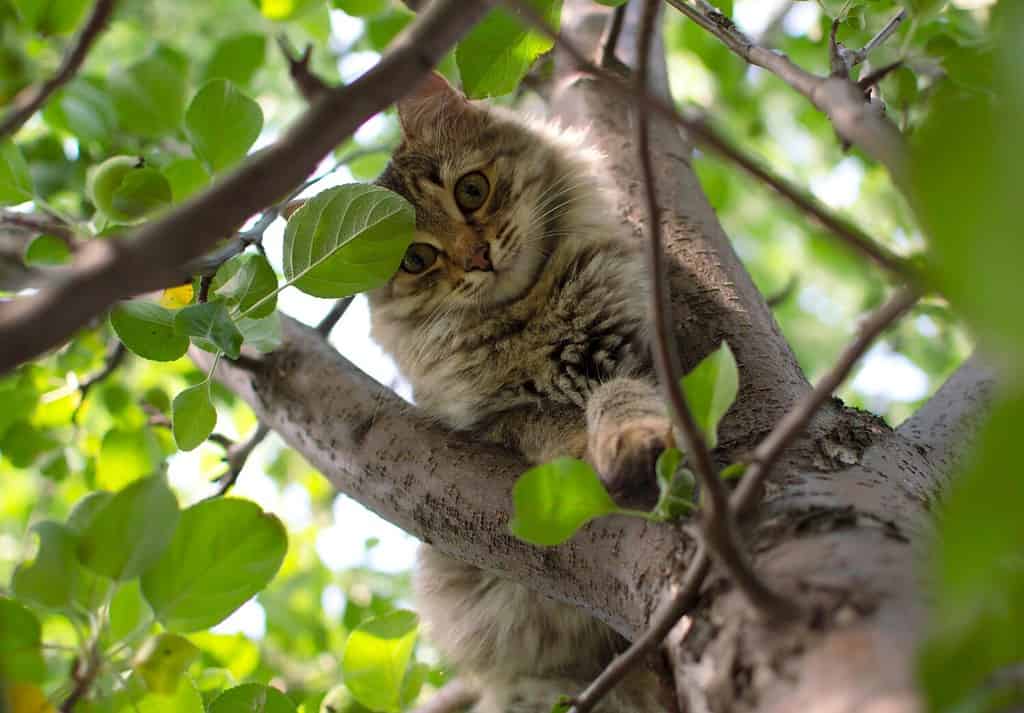Although they may not be considered “man’s best friend,” cats are surely high up on the list of animals that humans adore. They are also extremely agile and curious, which can often get them into some pretty sticky situations. For example, watch below as a mother cat scales a tree to save her kittens!
The clip begins by showing an adorable young kitten up in a tree, seemingly stuck. At the base of the tree, the kitten’s mother sits, meowing with anxiety. After watching her baby for a few seconds, she can’t stand it anymore and jumps into the tree to save it.
The mother attempts to grab her kitten to bring it down, but the baby housecat is too scared. It resists the assistance, clinging to the tree in fear. After a few more tries, the mom loses balance and returns to the ground. Fortunately, the kitten can slowly make its way down the tree, meeting back with its extremely happy mother!
How Long Do Housecats Live?

The oldest recorded cat was around 38 years old, however, most housecats live from around 12-16 years.
©Sergio Photone/Shutterstock.com
In contrast to the common saying that cats have nine lives, they unfortunately only have one. On average, most cats can live for around 12-16 years, especially if given loving care. For instance, giving your cat enrichment, taking it to regular health check-ups, and preventing it from getting into dangerous situations outdoors are all great ways to ensure it will live a long happy, and healthy life!
In terms of a cat’s lifespan, they have a few different life “phases”. The first phase is known as the “kitten” phase, which is in the first few months of a housecat’s life. In this phase, they are extremely curious and playful. These traits can get them into some trouble, as shown in the video below.
After this phase comes the “junior” and then “adult” phases, which make up the first six years of a cat’s life. In these phases, cats become less playful, but they maintain their same energy and drive to hunt.
Lastly, when housecats reach the end of their life, they enter their “senior” and “super senior” phases. In these phases, they lose a lot of their previous energy, begin to sleep more, and lose some of their youthful curiosity.
Why do Cats Climb Trees?

Cats are generally very curious and will climb trees to explore.
©Inna_Kandybka/Shutterstock.com
You may be asking yourself when you watch the video below, “Why would a housecat even climb a tree?” In most cases, the answer is curiosity and hunting.
As mentioned earlier, younger cats are extremely curious, especially when they encounter new things for the first time. Due to this, they tend to be very explorative, even when it comes to high-up places like trees.
Additionally, if an adult cat sees some sort of prey like a squirrel or bird in a tree, it will likely be driven to chase it. This is one of the main reasons why adult cats get caught up in trees.
How Large Are Adult Housecats?

The average mixed-breed cat can range in weight from 8 to 25 pounds, with some growing even larger with weight of around 28 pounds.
©GoodFocused/Shutterstock.com
House cats vary in size because they have different genetics that determine how large they may be. There are over eight large domestic breeds of cats. The average mixed-breed cat can range in weight from 8 to 25 pounds, with some growing even larger with weight of around 28 pounds. The lengths can range from 12 to 20 feet, not including the tail. The largest breed is the Maine Coon, which can reach an average of 20 pounds and lengths of up to 40 inches.
The photo featured at the top of this post is © Yiannis Papadimitriou/Shutterstock.com
Thank you for reading! Have some feedback for us? Contact the AZ Animals editorial team.







